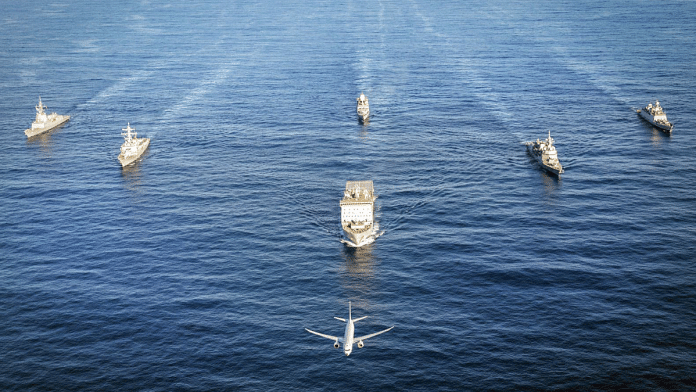New Delhi: Describing 2023 as a ‘decisive year’ for its engagement with India and the Indo-Pacific region at large, the United States Department of Defense Wednesday highlighted the country’s deepening defence cooperation with India through the proposed joint production of GE 414 fighter jet engines and Stryker armoured vehicles.
A statement released by the Pentagon Wednesday, highlighting efforts made to deploy cutting-edge technology and strengthen the capabilities of its “Indo-Pacific allies and partners”, listed “historic achievements” in the past year.
These included “bolstering India’s defense modernisation plans, including by advancing the priorities outlined in the Roadmap for U.S.-India Defense Industrial Cooperation to co-produce fighter jet engines and Stryker armored vehicles, as well as launching the India-U.S. Defense Acceleration Ecosystem (INDUS-X) to promote partnerships between U.S. and Indian researchers, entrepreneurs, and investors”.
2023 has seen major breakthroughs in defence cooperation between the US and India. During Prime Minister Narendra Modi’s official state visit to the US in June, India’s Hindustan Aeronautics Limited (HAL) and American conglomerate General Electric signed a memorandum of understanding to jointly produce fighter jet engines for the Indian Air Force.
The agreement included the potential joint production of GE’s F414 engines in India, subject to clearance from the US Congress. In August this year, the US Congress gave its approval to the deal.
Jet engine technology is considered the “holy grail” in aviation. As ThePrint reported earlier, while many countries, including India, produce their own fighter aircraft, the technology of engine manufacturing is limited to a few.
During the 2+2 ministerial dialogue in November, US Defense Secretary Lloyd Austin announced that Washington D.C and New Delhi would co-produce the Stryker armoured infantry combat vehicles as a part of defence industrial cooperation.
The past year also saw the launch of the India-United States Defense Acceleration Ecosystem (INDUS-X), aimed at co-developing and co-producing advanced defence technologies by Indian and US start-ups, with the involvement of both governments, businesses, and research institutions.
According to Atul Keshap, the president of the US-India Business Council, INDUS-X, which was launched in June at an event coinciding with Modi’s June visit to the US, will further facilitate India’s role as a “net security provider” in the Indo-Pacific.
In August 2023, a first-of-its-kind workshop was organised by IIT-Kanpur under the INDUS-X programme to foster defence cooperation, including in the field of artificial intelligence (AI) and space collaboration.
On 9 September 2023 — a day before the G20 leaders’ summit in New Delhi — US President Joe Biden and Modi discussed and commended the efforts of the INDUS-X team in establishing a “robust” collaboration agenda.
Also Read: From lows of 1970s to ‘defining’ partnership — a look at India-US ties & trade over the decades
Exercise MALABAR
As a part of the increased defence collaboration between the US and India, the US Department of Defense statement Wednesday highlighted the incorporation of advanced fighter aircraft and strategic bombers in joint exercises with India.
“…modernising the scope of our military engagements including by incorporating advanced fighter aircraft and strategic bombers in our exercises, which strengthens interoperability and highlights shared efforts to promote stability and security in the Indo-Pacific,” the statement read.
This year also witnessed the navies of the US, Japan, and India travel to Australia for the first time for the annual MALABAR exercise. The 10-day joint naval exercise focussed on interoperability when it comes to sea deterrence and sea denial in the Indo-Pacific. As ThePrint reported earlier, India sent the multi-role stealth frigate INS Sahyadri and the indigenous destroyer INS Kolkata for the exercise.
The exercise was mentioned in the Pentagon statement: “Exercise MALABAR with India, Japan, and Australia, hosted in Australia for the first time this year, which facilitated high-end training in anti-submarine exercises, communications, and air defence”.
(Edited by Uttara Ramaswamy)
Also Read: China expects Nijjar Pannun saga to affect India-US ties. It won’t, here’s why



